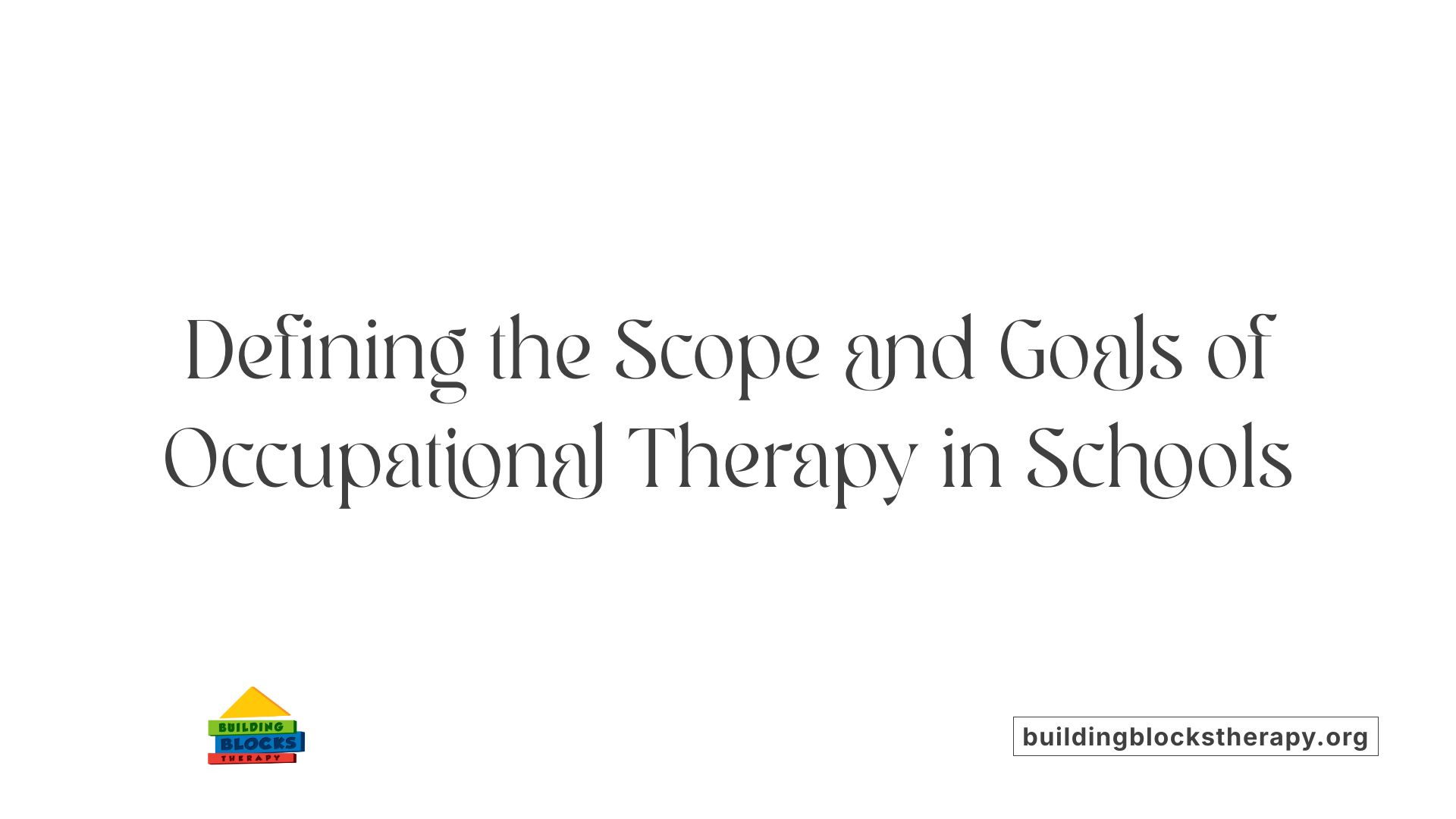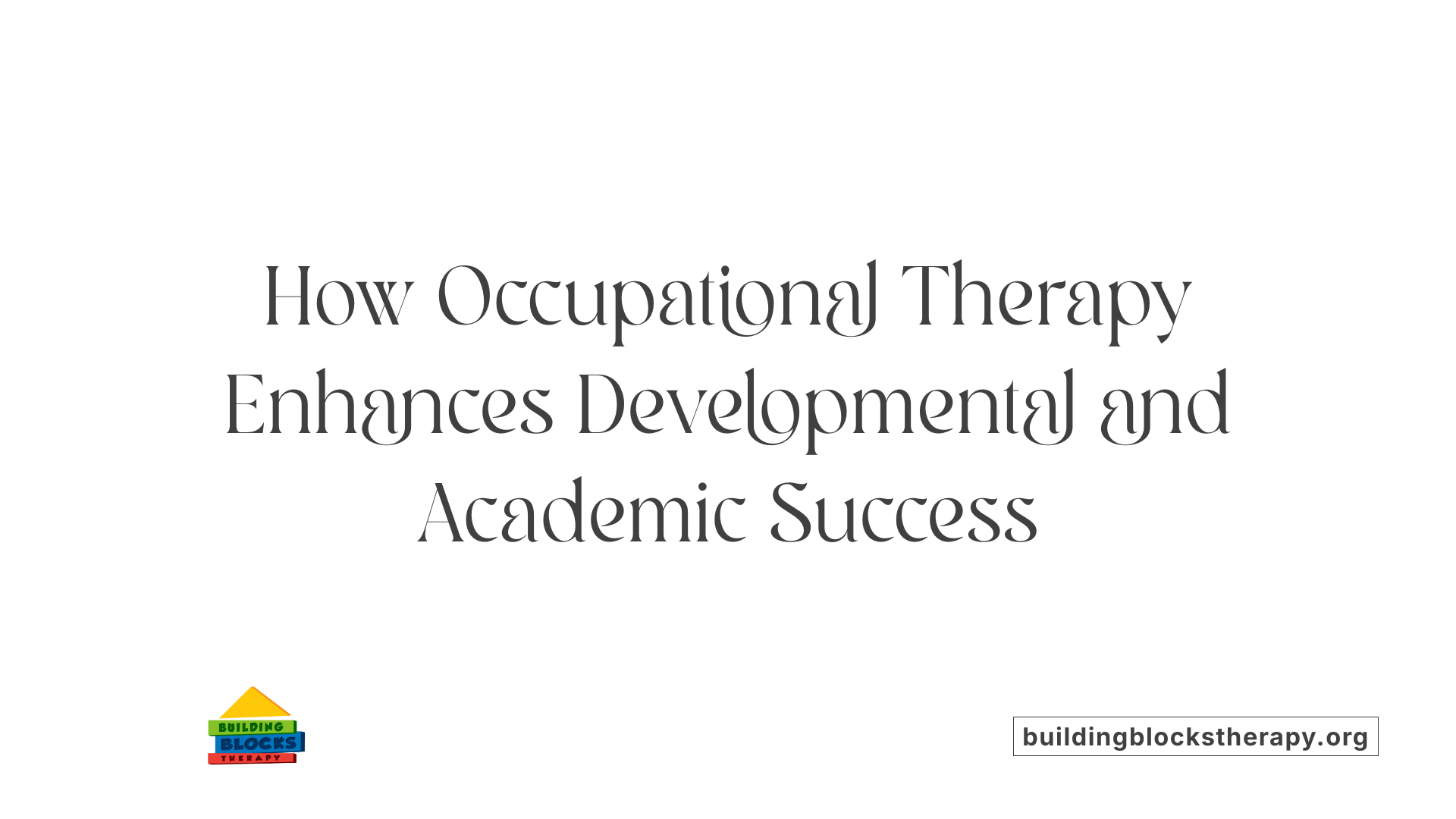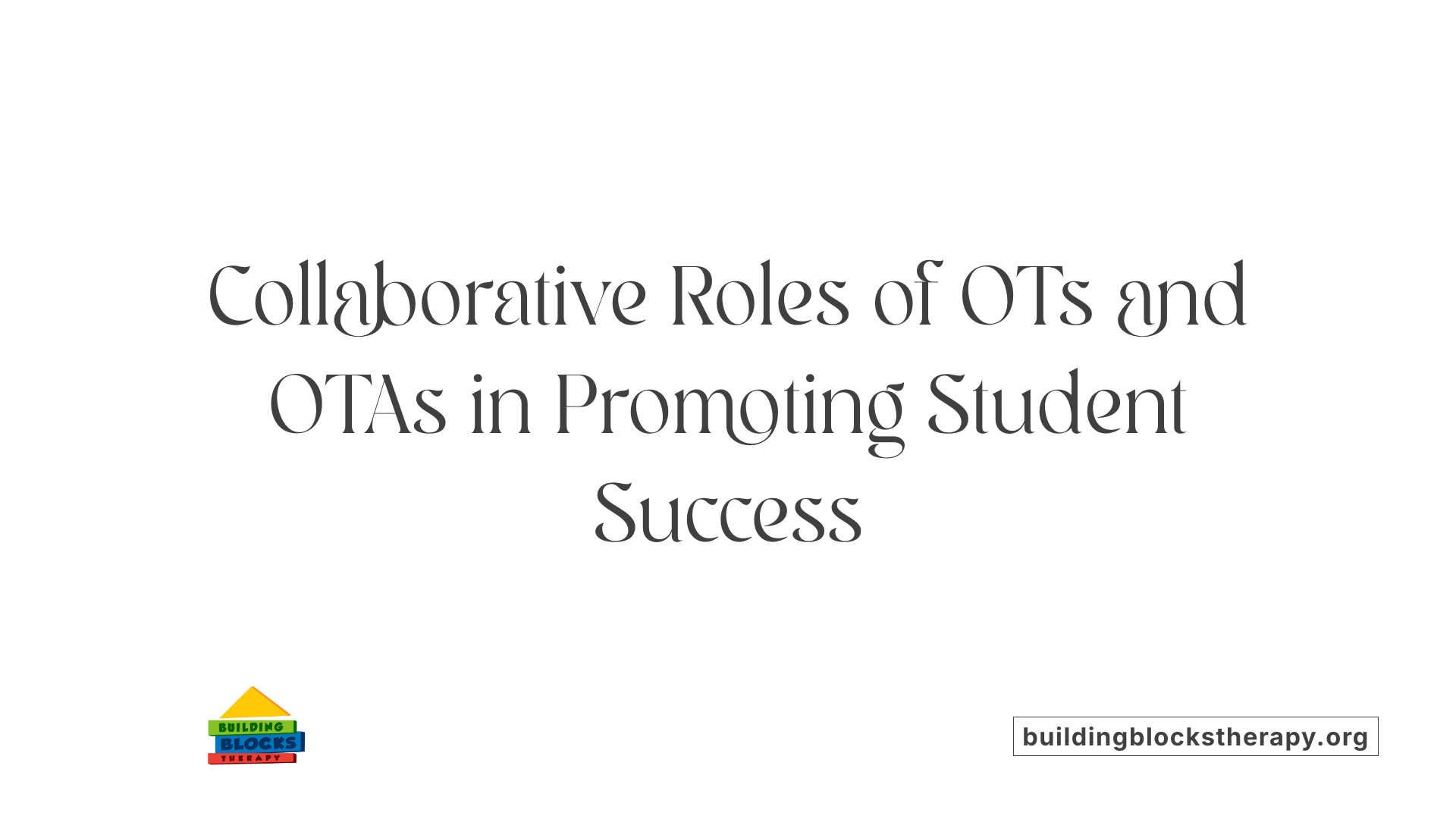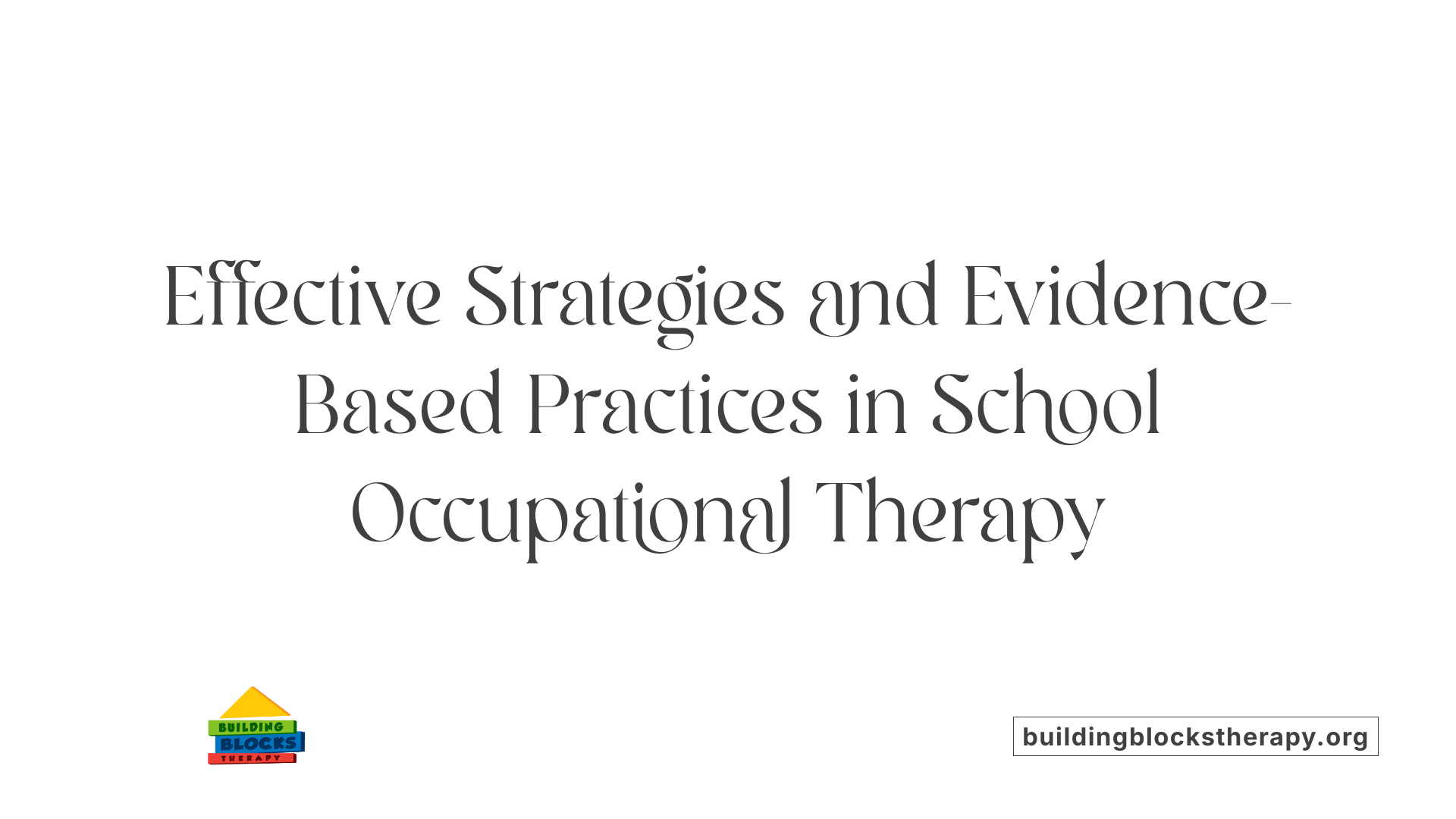The Benefits of Occupational Therapy in School Settings
Enhancing Student Success through School-Based Occupational Therapy

Unlocking Potential: The Role of Occupational Therapy in Education
Occupational therapy (OT) in school settings plays a pivotal role in supporting the diverse needs of students, fostering environments where every child can thrive academically, socially, and emotionally. From developing motor skills to improving emotional regulation, school-based occupational therapy ensures inclusive, accessible, and nurturing learning experiences that align with educational standards and promote lifelong well-being.
Understanding the Scope and Objectives of School-Based Occupational Therapy

What are the roles and responsibilities of occupational therapists and OT assistants?
School-based occupational therapists (OTs) are licensed healthcare professionals trained in child development and functional performance. They evaluate children by observing their participation in various activities, testing performance, and collaborating with teachers, parents, and healthcare providers. OTs develop individualized intervention plans focusing on motor, sensory, cognitive, and psychosocial skills.
OTs often work as part of a team that includes teachers, school psychologists, counselors, speech-language pathologists, and support staff. They provide direct therapy, environmental modifications, and training for school personnel and families to promote inclusion and independence.
Occupational therapy assistants (OTAs) support OTs by implementing treatment plans under supervision. They deliver specific interventions, assist in assessments, and facilitate activities that enhance the child's functional skills. Both OTs and OTAs use purposeful activities aligned with educational goals, employing strategies like adaptive tools, sensory diets, and task modifications.
How does occupational therapy support children with disabilities and special needs?
OT supports children with a wide range of disabilities, including autism spectrum disorder (ASD), attention deficit hyperactivity disorder (ADHD), developmental delays, sensory processing disorder, and physical disabilities. Therapists help improve skills necessary for academic success, social participation, and daily living.
For example,
- Children with ASD might receive accommodations like quiet workspaces or predictable schedules.
- Those with ADHD benefit from strategies to improve organization and reduce distractions.
- Children with coordination or motor difficulties learn handwriting, improve bilateral coordination, and use assistive devices effectively.
OTs also assess sensory processing challenges and develop sensory diets—tools like weighted vests, calming scents, or fidget objects—that help children manage sensory overloads and become more engaged in learning activities.
By addressing physical, cognitive, and psychosocial components, occupational therapists foster greater inclusion and participation, helping children access and succeed in their educational environment.
What are the goals of occupational therapy in schools?
School-based OT aims to maximize each student's participation in academic, social, and self-care activities. Common goals include:
- Developing and improving fine motor skills such as handwriting and keyboarding.
- Enhancing gross motor skills like running, jumping, and coordination.
- Supporting sensory processing to improve attention and self-regulation.
- Building independence in self-care tasks, including dressing, eating, and organizing school materials.
- Promoting social skills and peer interactions.
- Modifying classroom environments and using assistive technology to foster accessible learning.
OTs collaborate with educators, families, and support staff to set SMART+R goals—Specific, Measurable, Achievable, Relevant, Time-bound, and Revised—tailored to each child's needs. These goals are documented in the child's Individualized Education Program (IEP) and focus on developmental milestones, academic success, and transition planning.
Ultimately, the overarching goal is to create an inclusive, supportive environment where students can develop skills, gain confidence, and achieve their full potential—both academically and personally.
How do occupational therapists contribute to fostering inclusive and supportive school environments?
Occupational therapists play an essential role in fostering inclusion by adapting activities and environments to meet diverse student needs. They support the development of sensory-friendly classrooms, recommend assistive technologies, and guide teachers on strategies to accommodate learning differences.
By providing targeted interventions, OTs promote positive behavioral changes and emotional regulation, contributing to a healthy school climate. They also participate in school-wide programs like Response to Intervention (RTI) and Multi-Tiered System of Supports (MTSS), enabling early identification of challenges and providing timely, data-driven responses.
Additionally, OTs assist in staff training on motor skills, sensory integration, and behavioral strategies, empowering educators to support all learners effectively. They advocate for mental health support and promote recovery-oriented practices that boost students' self-esteem and identity.
Through these efforts, occupational therapists ensure that every student has access to an equitable and engaging educational experience, regardless of individual challenges.
| Aspect | Description | Further Details |
|---|---|---|
| Roles of OTs | Evaluate, plan, and implement interventions, collaborate with teams | Development of individualized goals, environmental adaptations |
| Support for Disabilities | Sensory processing, motor skills, behavioral challenges | Autism, ADHD, developmental delays, physical impairments |
| Goal Setting | Academic participation, social skills, independence | Use of SMART+R goals, documented in IEP |
| Environmental Modifications | Classroom adaptations, assistive tech | Making spaces accessible, sensory-friendly environments |
| Collaborative Activities | Training, resource sharing, team planning | Workshops, in-service training, family education |
Search terms: school-based occupational therapy benefits, OT roles in education, OT interventions and strategies, early intervention in schools, evidence-based OT practices in education, promoting inclusion through OT
The Impact of OT on Developmental and Academic Outcomes

How does occupational therapy support children with disabilities and special needs?
Occupational therapy (OT) plays a vital role in promoting the participation of children with disabilities and special needs in daily activities. It provides tailored interventions that foster their physical, sensory, cognitive, and social capabilities across varied environments—schools, homes, and community settings. OTs work closely with families, teachers, and other professionals to adapt environments, develop skills, and implement inclusive practices. This includes modifying learning materials, creating accessible spaces, and applying universal design principles. The primary goal is to boost independence, social integration, and overall quality of life for children with diverse needs, ensuring they can engage fully in activities that foster development and learning.
What role do occupational therapists play in supporting children with sensory processing issues such as SPD?
Children with sensory processing disorder (SPD) benefit greatly from specialized OT intervention. Occupational therapists design sensory diets—structured routines and activities that help regulate sensory input. These therapies may incorporate tools like weighted vests, calming scents, fidget toys, and chewing tools, which help children manage sensory overload or under-stimulation. By assessing sensory responses, therapists create individualized plans that blend sensory activities into daily routines, reducing stress and improving attention, self-regulation, and engagement in classroom or social settings. Sensory integration strategies facilitate better focus and social participation, essential for holistic development.
In what ways do occupational therapists facilitate the development of motor and visual perception skills?
OTs support motor skill development through activities aimed at improving bilateral coordination, fine motor skills such as handwriting, and gross motor activities like jumping or running. They also focus on visual perception, helping children interpret visual information—recognizing shapes, objects, understanding spatial relationships—using engaging games and interactive tasks. These interventions assist children in navigating their environment more effectively, which directly impacts academic tasks such as reading, writing, and math, as well as participation in physical activities. Developing these skills enhances a child's confidence and supports their overall academic and social success.
| Aspect Covered | Intervention Focus | Specific Strategies or Tools |
|---|---|---|
| Support for children with disabilities | Participation in daily activities | Environment modifications, collaboration with families and teachers |
| Sensory processing needs | Sensory regulation | Sensory diets, weighted vests, calming scents, fidget tools |
| Motor development | Fine and gross motor skills | Handwriting exercises, bilateral coordination activities, sports |
| Visual perception | Visual information processing | Shape recognition games, spatial relationship activities |
Additional Information and Resources
Exploring further research on OT's impact on development in schools, sensory processing interventions, and motor and visual perception enhancement can be facilitated through online databases and systematic reviews. Familiarity with evidence-based strategies supports professionals aiming to optimize therapeutic approaches for children with special needs.
Occupational therapy continues to evolve as an essential component of educational and developmental support, emphasizing a child-centered, inclusive approach that considers each child's unique profile and potential. Effective collaboration among multidisciplinary teams and ongoing professional development help ensure children receive comprehensive care to achieve their fullest potential in school and beyond.
Roles and Responsibilities of School-Based Occupational Practitioners

What roles do occupational therapists and OT assistants have in schools?
In school environments, occupational therapists (OTs) and occupational therapy assistants (OTAs) work together to support children facing physical, cognitive, psychosocial, and sensory challenges. OTs are licensed professionals responsible for comprehensive assessments, developing individualized goals such as those outlined in the child's IEP, and planning appropriate interventions. They utilize techniques like environmental adaptations, assistive devices, and sensory strategies to optimize learning and participation.
OTAs assist under the supervision of licensed OTs, delivering many of these interventions directly. Their roles include conducting screenings, providing therapy activities, and supporting students' motor, self-care, social, and emotional skills. Both OTs and OTAs aim to improve children's independence, enhance learning experiences, and foster positive social interactions. They also serve as vital consultants, offering training and resources to teachers and families to create inclusive, accessible environments for all learners.
This collaborative effort ensures a holistic approach to addressing each child's unique developmental and educational needs, helping students overcome barriers and thrive in their school setting.
How do occupational therapists collaborate with educators and families to support student success?
Effective collaboration is central to school-based occupational therapy. OTs work closely with teachers, support staff, and families to develop strategies tailored to each child's needs. They participate in team meetings to set individualized goals and regularly update progress, ensuring consistency and reinforcement across home and school settings.
OTs provide targeted training for educators, focusing on classroom modifications, sensory processing techniques, and adaptive tools. This empowers teachers to integrate therapeutic strategies into everyday instruction, fostering an inclusive environment. Regular communication through meetings, reports, and informal check-ins allows OTs to adjust interventions as needed.
Supporting families is equally important. OTs offer guidance on activities outside school, help parents understand their child's goals, and suggest home-based practices to reinforce progress. This continuous partnership promotes holistic development, ensuring that interventions are meaningful and effective for the child's overall well-being.
What distinguishes the responsibilities of OTs from those of OTAs within schools?
Within the school setting, the roles of OTs and OTAs are distinct yet complementary. Occupational therapists are licensed health care professionals with comprehensive training in assessment, diagnosis, and intervention planning. They oversee the entire therapy process, from evaluating students to designing individualized plans aimed at improving various functional skills.
OTAs support these efforts by delivering direct services under the supervision of a licensed OT. Their responsibilities include implementing therapeutic activities, conducting screenings, and assisting in data collection. They provide hands-on support during therapy sessions, help modify classroom environments, and reinforce therapeutic strategies.
This structure ensures that services are delivered safely and effectively, with OTs maintaining overall case responsibility while OTAs extend the reach of therapy through direct assistance. Together, they enhance the capacity of school-based occupational therapy programs to meet diverse student needs.
| Role | Responsibilities | Supervision & Scope |
|---|---|---|
| Occupational Therapist | Evaluation, goal setting, intervention planning, documentation, supervision | Full professional licensure, responsible for all case aspects |
| Occupational Therapy Assistant | Implementing therapy activities, screening, providing direct intervention | Under supervision of an OT, scope limited by training |
This collaboration promotes high-quality services that support student success and foster inclusive learning environments.
Strategies, Interventions, and Evidence-Based Practices in School OT

What strategies and interventions are used in school-based occupational therapy?
School-based occupational therapy (OT) employs a diverse range of strategies to support children’s participation and success in the classroom and other school activities. Practitioners focus on improving fine and gross motor skills, which include handwriting, using scissors, and bodily coordination necessary for sports and physical activities. Sensory processing and visual-motor integration are also common focus areas, helping children interpret visual stimuli and respond appropriately.
Interventions often involve modifications to the environment and teaching methods. These include sensory diets—customized plans that integrate tools like weighted vests, calming scents, or fidget tools to regulate sensory input. Assistive technology such as speech-to-text software, adapted seating, or communication devices is utilized to enhance accessibility.
OTs work directly with students through therapeutic activities, while also collaborating with teachers and families to adapt classroom routines and materials. Professional development sessions for school staff improve awareness and implementation of strategies. The overarching goal is to foster children's academic abilities, social skills, self-care, and self-regulation within the school setting.
What are the evidence-based practices that underpin effective occupational therapy in schools?
Effective school-based OT relies on evidence-based practices grounded in the latest research. Central to these is the use of multitiered service delivery models such as Response to Intervention (RTI) and Multi-Tiered System of Supports (MTSS), which ensure early identification, prevention, and targeted interventions.
Collaboration between occupational therapists and educational staff is crucial. Regularly sharing insights and data leads to tailored interventions that are contextually relevant and responsive to student needs. Universal Design for Learning (UDL) principles promote inclusion by designing activities and environments accessible to all children.
Interventions are supported by standardized assessments, such as the Sensory Profile or the School Functional Assessment, which help therapists determine specific needs and measure progress. Following guidelines from authoritative bodies like the American Occupational Therapy Association (AOTA) helps ensure practices are current and scientifically validated.
Integrating research-backed, child-centered, and occupation-focused strategies within a collaborative framework enhances intervention success, making school OT more effective and sustainable.
How does early intervention enhance outcomes for children with developmental delays?
Early intervention in occupational therapy plays a vital role in shaping positive long-term outcomes for children with developmental delays. The early years are critical for brain development, and timely services can address potential barriers before they become more entrenched.
By supporting areas such as motor skills, sensory processing, communication, and self-care, early OT helps children develop foundational abilities needed for school and social participation. Interventions are tailored to fit into daily routines, making strategies more natural and easier for families and teachers to adopt.
Family involvement is a cornerstone of effective early intervention. OT practitioners empower caregivers with techniques and resources, fostering consistency across settings like home and community environments.
Research indicates that children who receive early occupational therapy display improved independence, better behavioral regulation, and enhanced social skills. These benefits often translate into greater readiness for school, higher engagement levels, and improved emotional well-being, setting a strong foundation for future academic and life success.
| Approach | Core Focus | Benefits | Relevant Strategies |
|---|---|---|---|
| Motor Skills Development | Handwriting, coordination, mobility | Greater independence, improved academic performance | Therapeutic activities, adaptive tools, environmental modifications |
| Sensory Processing | Sensory diet, self-regulation | Better focus and emotional regulation | Use of calming tools, sensory rooms, weighted items |
| Visual-Motor Integration | Copying, tracking, spatial awareness | Enhanced reading and writing skills | Visual tracking exercises, multisensory activities |
| Assistive Technology | Speech-to-text, communication aids | Increased access to learning | Technology training, device adaptations |
| Family-Centered Services | Empowering caregivers | Sustainable skill development | Education, home program planning |
By implementing these strategies supported by current research, school-based occupational therapy continues to adapt and improve, ensuring that children with diverse needs can thrive academically and socially.
Fostering Inclusive and Supportive Educational Environments
Incorporating occupational therapy into school settings is essential for creating inclusive, supportive, and effective learning environments. OT helps address diverse developmental, physical, sensory, and psychosocial needs, facilitating academic achievement, social integration, and emotional well-being. As research continues to support evidence-based practices, the collaboration between occupational therapists, educators, families, and communities will be crucial in maximizing outcomes and ensuring every student's potential is realized. Investing in school-based OT not only promotes individual success but also cultivates a school culture rooted in inclusion, accessibility, and holistic development, ultimately enriching the educational experience for all.
References
- [PDF] What is the Role of the School-Based Occupational Therapy ... - AOTA
- School-Based Occupational Therapy - Stanford Children's Health
- Helping Students Succeed: School-Based Occupational Therapy
- How is Occupational Therapy used in school?
- Occupational Therapy Role in the School: Partnering for Change ...
- Potential Role of Occupational Therapist Intervention in Elementary ...
- Occupational Therapy in Schools (Guide + Directory) - OT Potential






